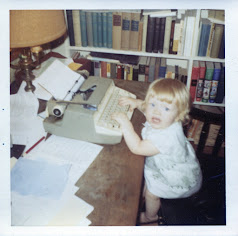In the last installment of my grandfather's story, he accepted the position of Financial Secretary of the Oriental Institute at the University of Chicago and he and my grandmother prepared to move from East Orange to Chicago.
 |
| Lunch with Dr. & Mrs. Nelson in the temple at Edfu. (My grandmother Dagmar Anderson is in the middle.) |
So we took off in our good little Chevy and drove to Chicago in April of 1935. There we lived in the Windermere Hotel (opposite the Museum of Science and Industry, near the lakefront) until our apartment on 57th Street, near the University, was made ready. This was in the Hyde Park section of Chicago, before that area had become run-down. We lived in that small-town-like area for 15 years, within a half dozen walkable blocks from my office at the University. And the winters were cold! But pausing briefly in University buildings along the way, I continued to walk. In fact, during the war years I had no choice, for in a burst of patriotism, we sold our car. Not the same Chevy, but a couple of models later.
The personnel of the Oriental Institute was a very interesting group,-the Chicago administration and faculty and especially the field staff, many of whom returned from the Near East during the off-season each year and worked on the recording of the past season's field work or on publications. Some, instead, continued their studies in England or Europe.
As Financial Secretary of the Institute my responsibilities included control of the budgets, sending operating funds and supplies to the four expeditions then operating in the Near East: the Epigraphic Expedition, located at Luxor, Egypt, where they were not excavating but copying the inscriptions on on the walls of the temples in that area; the Megiddo Expedition in Palestine which was excavating the site of Armageddon; the Persian (now Iran) which was excavating the site of the Temple of Darius and Xerxes at Persepolis; and the Syrian Expedition at Allepo, near Antioch. In addition, the Institute in cooperation with the Egypt Exploration Society of London, was engaged in publishing the large folio volumes of paintings copied from tombs in the Valley of the Kings, and this required frequent contact with Sir Allen Gardener and Nina deGaris Davies in London. And at the headquarters in Chicago there was the extensive publishing of the results of the aforesaid four active expeditions plus others whose field work had been completed or terminated, such as the Sakkhara Expedition at Memphis, near Cairo. The five active projects abroad required our operating in five different currencies, in addition to USA dollars: Egyptian Pounds, Palestinian Pounds, Iranian Rials, Syrian Livres, and English Pounds.
 |
| Anderson, Dagmar Alice Viola and Matthews, Stephen David ca 1936 |
 |
| Matthews, Stephen David |
Within our first year in Chicago, Steve was born, Charles Breasted retired from the Institute and I was promoted to his post as Executive Secretary of the Institute, and his father, James Henry Breasted, the head and founder of the institute, left on an inspection trip of the Institute's Near East activities, -- a trip from which he never got back to Chicago. He took ill on the return trip and was hospitalized and died in New York City. Before he left on that trip, Dr. Breasted said, "now, Matthews, I want you to take the next trip". A member of the staff, Egyptologist John A. Wilson, succeeded Dr. Breasted as Director of the Institute.
In 1938, Dagmar and I did the rounds of the Institute's expeditions in the Near East and its activities in London and at Oxford. Dagmar went along for "the woman's angle". Steve, then less than age 2, we left with Dagmar's brother and wife, Elmer and Isabel Anderson, in Manchester, Connecticut who graciously agreed to care for him while we were away. These were the days before trans-ocean flights. We left New York on the Italian liner REX on February 26, 1938 and returned on the English Aquitania on June 1, 1938. All of our travel was by water, train or automobile, as we were told one does not learn much in flying over a country. Details of the entire 3 months are contained in my own ITINERARY AND CALLS a copy of which is appended hereto, and in my diary and Dagmar's letters, both of which are in a Blue ring binder. In a Red binder there is a selection of the best of more than 1,000 pictures I took on this journey. Inspection of the diary reveals that my record is purely factual in that it relates to duty call s on persons, institutions, museums, etc., whereas Dagmar's letters to the folks back home, which they saved and returned to us, are a beautiful record of her reactions to the people and the countries we visited,--very worth-while reading.
The photos below are just a few of the many gorgeous photos that my grandfather took during this amazing trip-of-a-lifetime. I hope to share more in the future as I transcribe my grandmother's letters from the trip after I am finished with my grandfather's story. You should absolutely click on them to enlarge to full size, especially those of hieroglyphics which you will then be able to see in amazing detail. This album of photos and ephemera is one of the greatest treasures I own.
 |
| Statue of Liberty from the REX February 26, 1938 |
 |
| On the way to Sakkarah |
 |
| Dagmar bargaining - Baghdad, Iraq |
 |
| More at Edfu with Dr. & Mrs. Nelson |
 |
| Pay-day |
 |
| On the way to the temple at Edfu |
 |
| My grandparents in London. |

















No comments:
Post a Comment
If you don't wish to share your email address, please comment anonymously. Thank you.